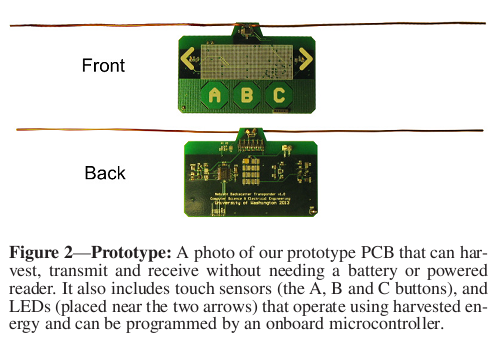Bojie Li
2013-08-02
Author’s note: Starting today, this blog will gradually roll out a series of articles, stepping into the upcoming top academic conference in the field of communication, SIGCOMM 2013, to see what Wireless & Networking researchers around the world are doing. Although these seemingly fancy designs may not work at all in a production environment, they at least point us in some possible directions.
Ambient Backscatter: Wireless Communication Out of Thin Air
Absorbing energy from space and using it as a power source, doesn’t that sound crazy? A research team from the University of Washington has created an RFID card that doesn’t need a power source, can draw energy from TV Towers available in every city to support sensors and microcontrollers, and reflect the energy of the TV Tower’s radio signals, enabling autonomous communication between two RFID cards no more than 50~75 cm apart, with a communication speed of up to 1kbps. To borrow an advertising phrase, it’s “We don’t produce signals, we’re just the porters of TV signals“.
2013-07-25
The wireless network at Vantone Inn requires username and password authentication. On Windows, as soon as you connect to the “Vantone Inn” access point, a browser window will pop up, displaying the user authentication interface. Visiting any HTTP address will also redirect to the authentication interface. Once authenticated, the wireless network is unobstructed. Today, a classmate asked me, how can this access point be so NB, can force the computer to pop up a window, is it a virus?
I don’t know the answer to this question, so I captured some packets and then Googled it. For ease of understanding, let’s not discuss the automatic pop-up of the browser first, let’s think about how to implement “visiting any HTTP address will redirect to the authentication interface”.
2013-07-24
As per the requirements of the Microsoft Scholars Program, I am to provide some suggestions for Bing’s products. I noticed that at MSRA, it seems that most people use Google. Why don’t they use Microsoft’s own Bing? Here are some technical comparisons.
Exact Matching Capability
The search keyword is “b4: experience with a globally-deployed software defined wan”, which is a paper from SIGCOMM 2013, announced around June.
In Google, only three keywords were entered, and the autocomplete has already come out. The first result is the paper itself, the second is the official SIGCOMM website, and all 10 results on the first page are relevant.
2013-07-23
USTC mainly has four outbound routes: Education Network (CERNET), Telecom, Mobile, and Unicom.
These four exits each have their own characteristics, let’s go through them one by one:
Education Network
- The full name of the Education Network is “China Education and Research Computer Network” (CERNET), which connects universities and research institutions nationwide. The main node is in Beijing (the headquarters is in Tsinghua Science Park, next to Google), and USTC is the core node in Anhui Province.
- IPv4 bandwidth 2G
- IPv6 bandwidth 2G, relatively loose (Liuwei is IPv6, very fast)
- The north-south interconnection within the Education Network is quite congested during the day, and the network is more smooth at night. The north-south interconnection problem of other operators may be more serious.
- Access to other domestic operators and foreign countries is very slow
- The routing path on the network is not necessarily the shortest geographically, for example, the traffic from USTC to Beijing may have to go through Shanghai.
- Access to IPs outside the “free addresses” defined by CERNET is charged by traffic. Although it does not charge us directly, try to save money for the school :)
- Everyone is advised to use IPv6 when accessing resources within the Education Network
2013-06-24
Note: The following content is purely from memory. As it has been over a month, accuracy is not guaranteed. Since no confidentiality agreement was signed before the interview, this article reveals quite a lot of details. If there is any inappropriate content, please contact bojieli AT gmail.com.
Originally, I wanted to secure a research position and work hard in a startup team. I didn’t think about going to MSRA… Therefore, it wasn’t until a few days before the application deadline that I learned about this news from my class teacher. The teacher said there was a “Microsoft Scholar” award, which was worth 5000 yuan. I thought with so many scholarships, I definitely wanted it. So I rushed to write a two-page Resume with MS Word one night, went to the academic secretary’s office to get a transcript the next day, and submitted the application one day after the deadline. It was only later that I found out that this “Microsoft Scholar” was tied to the “experimental class” to some extent, but I haven’t received any news about that scholarship yet.
According to the email recipient list, about 67 people signed up for the Microsoft experimental class. The interview was in the afternoon. About a week before the interview, a teacher from the West District contacted me, saying that there was a researcher named Ma Yi, who was very good at image processing and wanted to recruit a student from the Youth Academy. He said that my project experience and hands-on ability were good, but my math grades were not good, and he was worried about whether I could do it. He could give me a chance for a separate interview. He said he didn’t care about your overall GPA, what he cared more about were the grades of math courses and professional courses. He asked me to look at one of Dr. Ma Yi’s representative works, not only to understand it but also to grasp its essence. When I came back and looked at it, it was a general algorithm that decomposes a matrix into the sum of a sparse matrix and a low-rank matrix, which can be used for image denoising, video surveillance, etc. I only understood so much, and I couldn’t understand the complex derivation of the matrices in the middle at all. I thought this opportunity should be left to students majoring in mathematics.
2013-05-14
GNU (GNU’s Not Unix) Project
Launched publicly by Richard Stallman on September 27, 1983, the goal is to create a completely free operating system. The GNU project has contributed many top-notch software, including GCC, Emacs, etc.
2013-05-13
Yesterday, a bizarre thing happened to mirrors.ustc.edu.cn. Mirrors has three access lines, with IPs 202.38.95.110, 202.141.160.110, and 202.141.176.110 respectively. Mirrors-lab is an LXC virtual machine on mirrors, with three IPs: 10.8.95.2, 10.8.140.2, 10.8.10.2.
On the mirrors host, iptables is configured to directly map the 50000~51000 ports on the host to the virtual machine:
1 | -A PREROUTING -p tcp -d 202.38.95.110 -m multiport --dports 50000:50100 -j DNAT --to 10.8.95.2 |
The rsync daemon is running on port 50000 of the virtual machine, but only rsync://202.38.95.110:50000 can be accessed, the other two IPs are timed out. The bizarre thing is, we captured packets with tcpdump on the mirrors virtual machine and host, it seems that SYN has been received, and ACK packets have also been sent out. Tcpdump captures inbound packets before netfilter, we captured the physical network card eth0, inbound packets should not have reached iptables when they were captured, and outbound packets have passed iptables when they were captured. Even more bizarre is that on the blog server, which belongs to the same network segment as mirrors, all three IPs are accessible normally. Why can’t the reply packets be sent out of the local network?
2013-03-19
Please read first: About Open Source Software Mirror Alliance (Non-Technical Part), thank you
I. DNS or 301?
Update: I previously misunderstood DNS’s CNAME, now corrected. Reference: https://tools.ietf.org/html/rfc3568
DNS solution (if I’m wrong, feel free to correct me):
Assign a secondary domain name to each mirror for separate scheduling; set NS record to the main site
User queries IP from ISP DNS
The main site returns one or more IP addresses of mirror nodes based on the source IP (ISP DNS’s IP)
ISP DNS returns this IP to the user, and caches it for a certain period
User establishes a connection with the mirror node and downloads
301 solution:Domain A record resolves to the main site
User establishes a connection with the main site and initiates an HTTP request
The main site returns HTTP 301 status based on the user’s source IP, redirecting to a mirror node
User establishes a connection with this mirror node and downloads
2013-03-19
Terminology: (It feels quite awkward)
- Mirror: Like Ubuntu, CPAN, PyPi, etc.
- Mirror site: An open source mirror site at a university, each mirror site hosts several mirrors
- (Mirror) Node: Each mirror site that hosts the same mirror
Mirror Alliance Maintainers:
Following the Debian development model, the maintainers of the Mirror Alliance can be divided into Mirrors Maintainer and Mirrors Developer. Mirrors Developer are core developers who have maintenance access and decision-making voting rights on the main site of the Mirror Alliance; anyone involved in the development and maintenance of the Mirror Alliance can apply to become a Mirrors Maintainer.
2012-11-27
Welcome to USTC Blog. USTC Blog, after much anticipation, is finally online! This is a moment worth celebrating, but it also means that we will be continuously battling with bugs and features in the coming days.
Just daydreaming, when can the blog reach the traffic volume in the following picture?
The above picture is the traffic graph of mirrors.ustc.edu.cn

